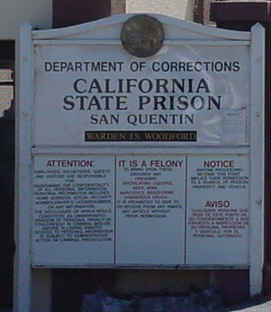|
San Quentin Johnny Cash sang this about San Quentin prison: "I hate every stone of you."
Johnny Cash sang this about San Quentin prison: "I hate every stone of you."
San Quentin Prison is the oldest prison in California. Located north of San Francisco, in the heart of one of the state's most affluent areas, San Quentin Prison is California's only death row with a Gas Chamber. All male inmates condemned to die are housed here. The prison opened in 1852 and was built mostly by convicts, who slept on a ship at night until the job was completed. San Quentin has a bloody reputation, a culture where violence and boredom make up life day-by-day, where gang culture, rape and silence runs deep. Guards know that inmates can make a weapon out of anything and often they do. Cell blocks in San Quentin have names or perhaps warning signs: "Little Viet Nam", "Death Alley", "Okay Corral". The prison itself has an appropriate nickname given to it by inmates: "The Arena".
The first gas chamber execution was carried out in 1938. The view from the gas chamber is the last sight a condemned man sees in life. The chamber at San Quentin is kept in the basement and is simply a large green box. Six feet across, eight feet high with a 30 foot chimney to exhale gas. Gassing is painful and dangerous, not just to the victim but to the staff and witnesses as well. A gas chamber must be well maintained to avoid leaking gas. Death by hydrogen cyanide gas (2 NaCn + H2SO4 = 2 HCN + Na2SO4) is a messy business but less so than the previous choices available until 1890: electrocution and hanging. San Quentin's gas chamber works like so: The subject is sealed in an air-tight, pressurized chamber. Pellets (or more accurately, briquettes) of sodium cyanide are mixed with sulfuric acid within the chamber. The subject, after a series of epileptic motions, dies from hypoxia, a condition that occurs when the brain fails to get oxygen. Death by gassing doesn't happen immediately, the prisoner is expected to play along and inhale the deadly fumes. It takes about ten minutes of twitching and straining against the straps for our subject to die. After ten minutes or so, the chamber is ventilated (another fifteen minutes). The remaining gasses are evacuated and the state is left with a corpse that must be scrubbed with bleach before it can be handled.
It takes 1,500 staff members to manage the nearly 6,000 inmates on the grounds, including the 550 condemned prisoners. These numbers, dated Winter 2003 from California's Department of Corrections web page, show that the prison was only designed to hold 3,317 prisoners. The annual operating budget of San Quentin State Prison? $120,000,000.00. Considering that the prison's location is very desirable property, with views of the San Francisco Bay Area and convenient access to Silicon Valley, it is likely inmates will be shipped off to other prisons around California within the decade.
timeline
|
 From 1893 to 1942, California's preferred method of execution was hanging. In this time, 215 inmates had their necks broken with a resounding thud. Hangings were only slightly less brutal than the gas chamber, with heads popping off and ropes breaking.
From 1893 to 1942, California's preferred method of execution was hanging. In this time, 215 inmates had their necks broken with a resounding thud. Hangings were only slightly less brutal than the gas chamber, with heads popping off and ropes breaking.
